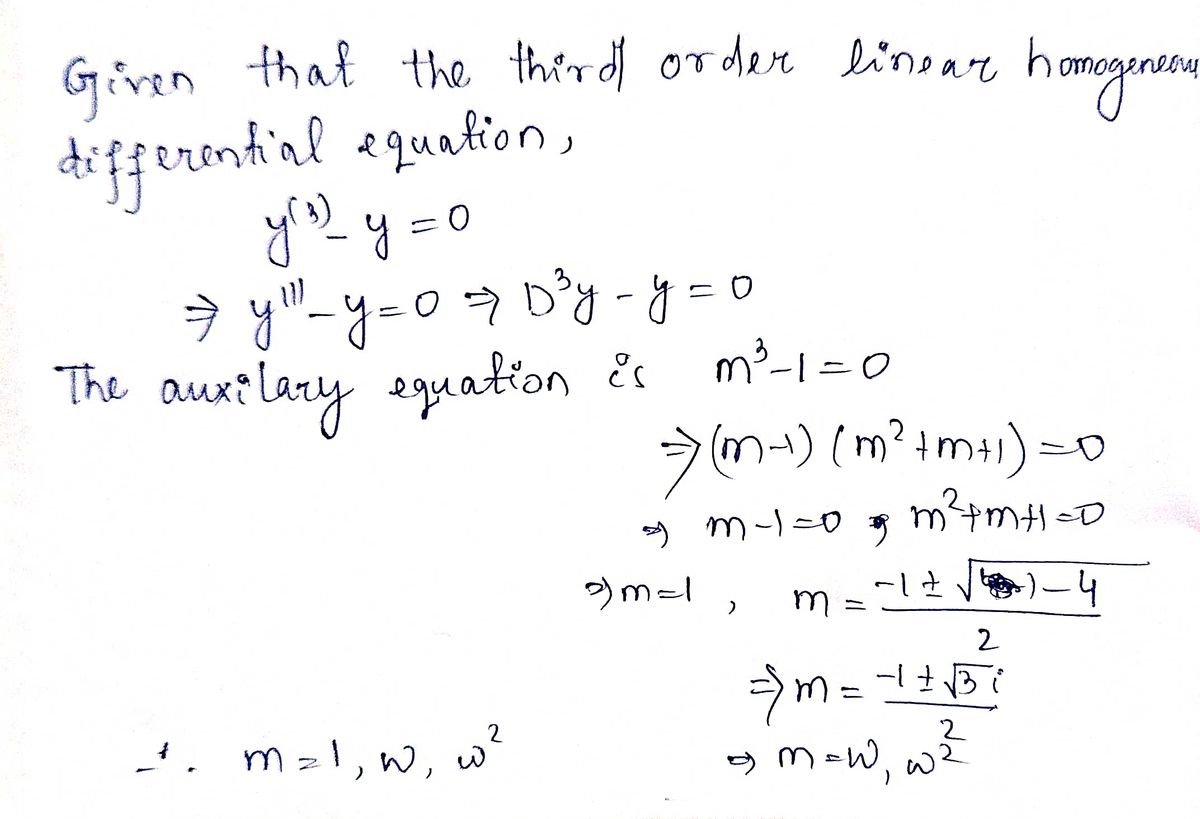Given the third-order linear homogeneous differential equation: y (3) - y=0 Select all correct answers Hide answer choices A A B If y (0)=0. y' (0) =1. y' (0) = -1 3 (-1/2) sin( et, e then y=(- 2 is a solution of the associated initial value problem. Three linearly independent solutions of the given differential equation are: el X x + x) -*/2, xe¯*/2
Given the third-order linear homogeneous differential equation: y (3) - y=0 Select all correct answers Hide answer choices A A B If y (0)=0. y' (0) =1. y' (0) = -1 3 (-1/2) sin( et, e then y=(- 2 is a solution of the associated initial value problem. Three linearly independent solutions of the given differential equation are: el X x + x) -*/2, xe¯*/2
Advanced Engineering Mathematics
10th Edition
ISBN:9780470458365
Author:Erwin Kreyszig
Publisher:Erwin Kreyszig
Chapter2: Second-order Linear Odes
Section: Chapter Questions
Problem 1RQ
Related questions
Question
![### Differential Equations Overview
The image contains a discussion on differential equations, specifically focusing on linearly independent solutions and initial value problems.
**Section C: Linearly Independent Solutions**
Three linearly independent solutions of a given differential equation are presented:
1. \( e^x \)
2. \( e^{x/2} \sin\left(\frac{\sqrt{3}}{2} x\right) \)
3. \( e^{x/2} \cos\left(\frac{\sqrt{3}}{2} x\right) \)
These forms represent a combination of exponential and trigonometric functions, often appearing in solutions to second-order linear differential equations with complex roots.
**Section D: Solution Verification**
It specifies that:
- \( y \equiv 0 \) is a solution of the differential equation \( y^{(3)} - y = 0 \).
This implies that the zero function satisfies the differential equation, acting as a trivial solution.
**Section E: Another Set of Linearly Independent Solutions**
Three alternative linearly independent solutions are provided for another differential equation:
1. \( e^x \)
2. \( e^{-x/2} \sin\left(\frac{\sqrt{3}}{2} x\right) \)
3. \( e^{-x/2} \cos\left(\frac{\sqrt{3}}{2} x\right) \)
These solutions, similarly to Section C, involve exponential decay and oscillatory behavior, suggesting complex conjugate roots.
**Section F: Initial Value Problem**
Given initial conditions:
- \( y(0) = 0 \)
- \( y'(0) = 1 \)
- \( y''(0) = -1 \)
The solution to the initial value problem is specified as:
\[ y = \left(\frac{2}{\sqrt{3}}\right)e^{(-x/2)}\sin\left(\frac{\sqrt{3}}{2} x\right) \]
This solution combines initial conditions with the linearly independent solutions to form a particular solution that satisfies both the differential equation and the specified initial conditions.
### Summary
The discussed sections showcase different solution techniques for differential equations, emphasizing the importance of finding linearly independent solutions and applying initial conditions to derive particular solutions in a well-defined context.](/v2/_next/image?url=https%3A%2F%2Fcontent.bartleby.com%2Fqna-images%2Fquestion%2F6d11a2cb-f5e2-441d-8b2a-04ce207dc9df%2Fb5a4ebf2-25d8-4d43-8a44-cf9ee790ee87%2Fxmnd32_processed.jpeg&w=3840&q=75)
Transcribed Image Text:### Differential Equations Overview
The image contains a discussion on differential equations, specifically focusing on linearly independent solutions and initial value problems.
**Section C: Linearly Independent Solutions**
Three linearly independent solutions of a given differential equation are presented:
1. \( e^x \)
2. \( e^{x/2} \sin\left(\frac{\sqrt{3}}{2} x\right) \)
3. \( e^{x/2} \cos\left(\frac{\sqrt{3}}{2} x\right) \)
These forms represent a combination of exponential and trigonometric functions, often appearing in solutions to second-order linear differential equations with complex roots.
**Section D: Solution Verification**
It specifies that:
- \( y \equiv 0 \) is a solution of the differential equation \( y^{(3)} - y = 0 \).
This implies that the zero function satisfies the differential equation, acting as a trivial solution.
**Section E: Another Set of Linearly Independent Solutions**
Three alternative linearly independent solutions are provided for another differential equation:
1. \( e^x \)
2. \( e^{-x/2} \sin\left(\frac{\sqrt{3}}{2} x\right) \)
3. \( e^{-x/2} \cos\left(\frac{\sqrt{3}}{2} x\right) \)
These solutions, similarly to Section C, involve exponential decay and oscillatory behavior, suggesting complex conjugate roots.
**Section F: Initial Value Problem**
Given initial conditions:
- \( y(0) = 0 \)
- \( y'(0) = 1 \)
- \( y''(0) = -1 \)
The solution to the initial value problem is specified as:
\[ y = \left(\frac{2}{\sqrt{3}}\right)e^{(-x/2)}\sin\left(\frac{\sqrt{3}}{2} x\right) \]
This solution combines initial conditions with the linearly independent solutions to form a particular solution that satisfies both the differential equation and the specified initial conditions.
### Summary
The discussed sections showcase different solution techniques for differential equations, emphasizing the importance of finding linearly independent solutions and applying initial conditions to derive particular solutions in a well-defined context.
![Given the third-order linear homogeneous differential equation:
\[ y^{(3)} - y = 0 \]
**Select all correct answers**
---
**A**
If \( y(0) = 0, \ y'(0) = 1, \ y''(0) = -1 \),
then \[ y = \left(\frac{-2}{\sqrt{3}}\right) e^{(-x/2)} \sin \left( \frac{\sqrt{3}}{2} x + \pi \right) \]
is a solution of the associated initial value problem.
---
Three linearly independent solutions of the given differential equation are:
**B**
\[ e^x, \ e^{-x/2}, \ x e^{-x/2} \]](/v2/_next/image?url=https%3A%2F%2Fcontent.bartleby.com%2Fqna-images%2Fquestion%2F6d11a2cb-f5e2-441d-8b2a-04ce207dc9df%2Fb5a4ebf2-25d8-4d43-8a44-cf9ee790ee87%2Fxtplvuh_processed.jpeg&w=3840&q=75)
Transcribed Image Text:Given the third-order linear homogeneous differential equation:
\[ y^{(3)} - y = 0 \]
**Select all correct answers**
---
**A**
If \( y(0) = 0, \ y'(0) = 1, \ y''(0) = -1 \),
then \[ y = \left(\frac{-2}{\sqrt{3}}\right) e^{(-x/2)} \sin \left( \frac{\sqrt{3}}{2} x + \pi \right) \]
is a solution of the associated initial value problem.
---
Three linearly independent solutions of the given differential equation are:
**B**
\[ e^x, \ e^{-x/2}, \ x e^{-x/2} \]
Expert Solution
Step 1

Step by step
Solved in 4 steps with 4 images

Recommended textbooks for you

Advanced Engineering Mathematics
Advanced Math
ISBN:
9780470458365
Author:
Erwin Kreyszig
Publisher:
Wiley, John & Sons, Incorporated

Numerical Methods for Engineers
Advanced Math
ISBN:
9780073397924
Author:
Steven C. Chapra Dr., Raymond P. Canale
Publisher:
McGraw-Hill Education

Introductory Mathematics for Engineering Applicat…
Advanced Math
ISBN:
9781118141809
Author:
Nathan Klingbeil
Publisher:
WILEY

Advanced Engineering Mathematics
Advanced Math
ISBN:
9780470458365
Author:
Erwin Kreyszig
Publisher:
Wiley, John & Sons, Incorporated

Numerical Methods for Engineers
Advanced Math
ISBN:
9780073397924
Author:
Steven C. Chapra Dr., Raymond P. Canale
Publisher:
McGraw-Hill Education

Introductory Mathematics for Engineering Applicat…
Advanced Math
ISBN:
9781118141809
Author:
Nathan Klingbeil
Publisher:
WILEY

Mathematics For Machine Technology
Advanced Math
ISBN:
9781337798310
Author:
Peterson, John.
Publisher:
Cengage Learning,

